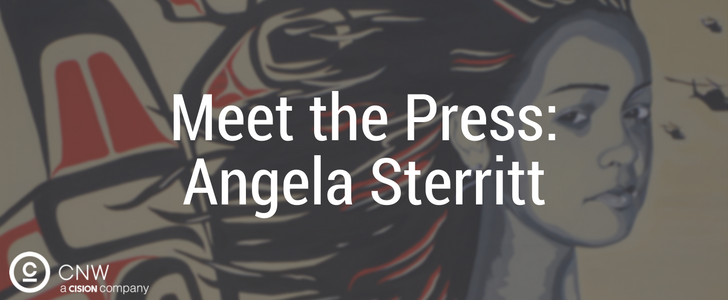By Nadine Tousignant for CNW
Angela Sterritt is an award-winning Gitxsan journalist, artist and writer, from British Columbia. Sterritt has worked as a journalist for close to twenty years and has been with CBC since 2003. Her reports have appeared in the Globe and Mail, The National, CBC’s The Current, and various other national and local news programs. She tells us about the importance of compelling storytelling through people’s experience.
Another reward of my job is having the tools to tell a robust and accurate story that illustrates the multiple dimensions of Indigenous communities. Too often in news stories, Indigenous people’s lives are wrought with tropes and stereotypes, which creates an inaccurate picture of who Indigenous people are. For example, sharing the complex and delicate stories of missing and murdered Indigenous women very early on in my career, I was able shed light on the strife of family members to be heard and the challenges they faced. Today, one of the highlights of my career remains when I reporting on Indigenous people’s relationship to the oilsands. My series showcased a reality that there are not just two sides of Indigenous people – those who want industry and those who fight against it, but like all humans, Indigenous people live within complex realities.
How do you use social media?
Mainly to share news stories. When I am in the news reporter pool, I’ll share updates of the story I am working on that day (or hour). I’ll send video highlights or live tweet a press conference for example, post interview clips if I am out in the field or share still shots of a scene I am on. I once live tweeted an entire Shell Oil tour the company gave us, that allowed us exclusive access to the expansion of their Jackpine Mine and reclamation efforts they were working on. It was a decision my cameraperson was not a fan of but it was something that gave thousands of people instant access to an area of Canada that is often closed to the public. When I am working on a long-form investigative story, I may share elements of my story on social media that are, for the most part, already part of public discourse. For example, I recently spent about 50 hours driving along the Highway of Tears, and tweeted some of the compelling billboards of missing women, red dresses that were hung along the highway and provided updates or reminders on specific cases.
Continue reading this on the CNW website, where it was first published.

